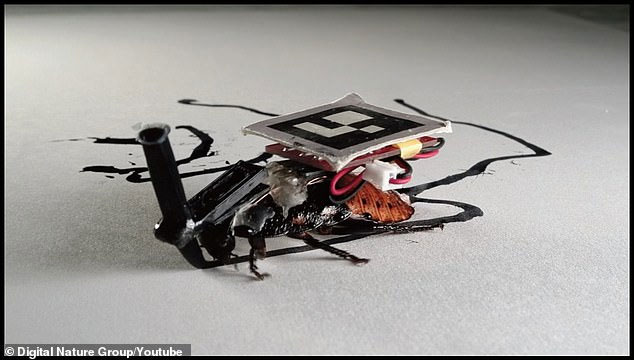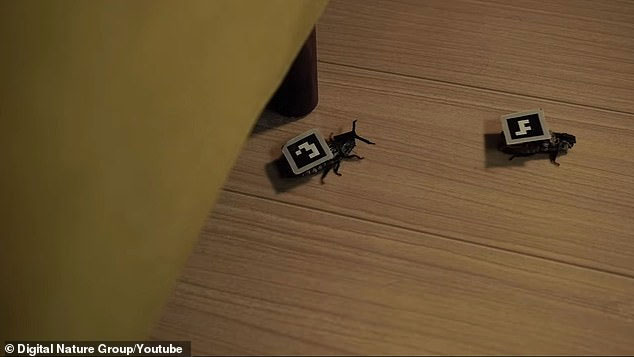Japanese scientists implant machines into cockroaches, forcing them to serve humans
According to the Daily Mail, a research team at Tsukuba University has implanted control microchips into Madagascar cockroaches, allowing them to navigate the insects on walls or floors - places that other robots have difficulty reaching.
Called "Calmbot" , the cockroaches will be equipped with electrodes, antenna chips, batteries and pixel panels that act as screens on their backs. The team says these cyborg cockroaches can move things around the house, draw things on paper, etc.

Portraits of cyborg cockroaches - half cockroach half machine.
Among the myriad of cockroach species that exist on Earth, the Madagascar hissing cockroach was chosen by the research team because of its flexible mobility, self-healing ability, and excellent ability to find hiding places. When the assigned task is completed, the cockroaches will hide in dark areas to 'sleep', before being called back when we need them.
"In the future, they will suddenly appear out of nowhere without us knowing, complete their mission, and then disappear again."

The cockroaches will be equipped with electrodes, antenna chips, batteries and pixel panels that act as screens on their backs.
The team tested the ability to control cyborg cockroaches to move along walls, through carpets or floors using a cable attached to the cockroach's body. To be able to control multiple cyborg cockroaches at the same time, the team developed a control method based on the working principle of worker ants in an ant colony.
'When the cockroaches got out of control, we used replacement cockroaches to continue the ongoing mission.
Researchers hope to use cyborg insects for search and rescue operations. However, if the cyborgs need to be used for a long time, the lithium batteries will not have enough power, and if the battery runs out, the insects may run away.
To solve this problem, researchers have integrated ultra-thin solar cells into the cockroach's abdomen. Although only 0.004 mm thick, they can provide 50 times the power required for the control circuit.
In the early stages, the solar panels hinder the cockroaches' ability to move, making them slow and unable to regain balance if they are turned over.
After adjusting the location and arrangement, the researchers successfully integrated a 17.2 mW solar cell into the cyborg without affecting the cockroach's ability to move.

Diagram of the electronic components of a cyborg cockroach. (Photo: Nature).
"To perform search and rescue missions in residential areas, cyborg insects contain computer circuits for motion control, human-detection sensors, and wireless communication devices. They require 10-100 mW of total power consumption. Therefore, insect-mounted energy harvesting devices are important to increase the operating range and functionality," said Kenjiro Fukuda, co-author of the study.
According to Fukuda, some scientists have wanted to create cyborgs for other insects, such as butterflies or beetles. However, most cannot be equipped with energy harvesting devices because they reduce their mobility. That is why successfully integrating solar cells into cyborg cockroaches is a remarkable achievement of the research.
In the future, the team wants to develop cyborgs based on other insects, including species that can fly.
Compared to soft robots (robots that use flexible materials to move and transform flexibly), cyborg insects are cheaper, faster to integrate, and consume less energy. An important feature is that cyborgs can still receive signals using biological senses to move, something that soft robots cannot achieve.
- Humans will perish before cockroaches?
- New discovery: Cockroaches also know learning!
- Catastrophic flying disaster: Why do they always face us straight down?
- Every house has cockroaches but does anyone know where they are coming from?
- Eating less nutritious food makes fatty cockroaches more
- Materials for implant equipment from squid teeth
- Stunned art of cockroaches
- Use cockroaches
- Japanese experts share how to kill cockroaches and avoid this nasty animal
- Implant machines into insects - A new future for spy technology?
- The secret of cockroaches
- Cockroaches also have personality like humans
 The US company is about to build a supersonic passenger plane of 6,000km / h
The US company is about to build a supersonic passenger plane of 6,000km / h Japan develops avatar robot as in fiction film
Japan develops avatar robot as in fiction film Australia tested the world's first mango picking robot
Australia tested the world's first mango picking robot America develops technology to separate water from animal waste
America develops technology to separate water from animal waste Amazing ability of tiny 'powerhouses' to live longer than dinosaurs
Amazing ability of tiny 'powerhouses' to live longer than dinosaurs  How did German cockroaches invade the world?
How did German cockroaches invade the world?  Cockroaches are becoming more and more numerous, 'mutating' and not afraid of drugs
Cockroaches are becoming more and more numerous, 'mutating' and not afraid of drugs  Japanese experts share how to kill cockroaches and avoid this nasty animal
Japanese experts share how to kill cockroaches and avoid this nasty animal  The cleanest cockroach in the world: Thanks to its beauty, it is given special treatment to become a human pet
The cleanest cockroach in the world: Thanks to its beauty, it is given special treatment to become a human pet  Why did cockroaches survive when a meteor wiped out the dinosaurs?
Why did cockroaches survive when a meteor wiped out the dinosaurs? 